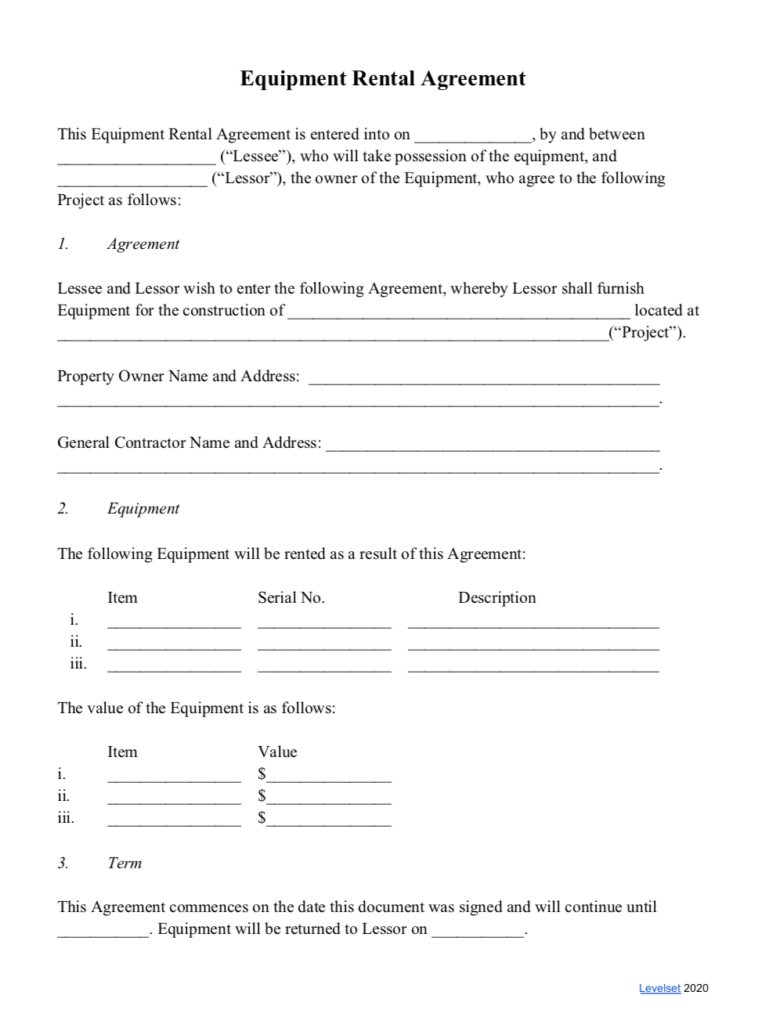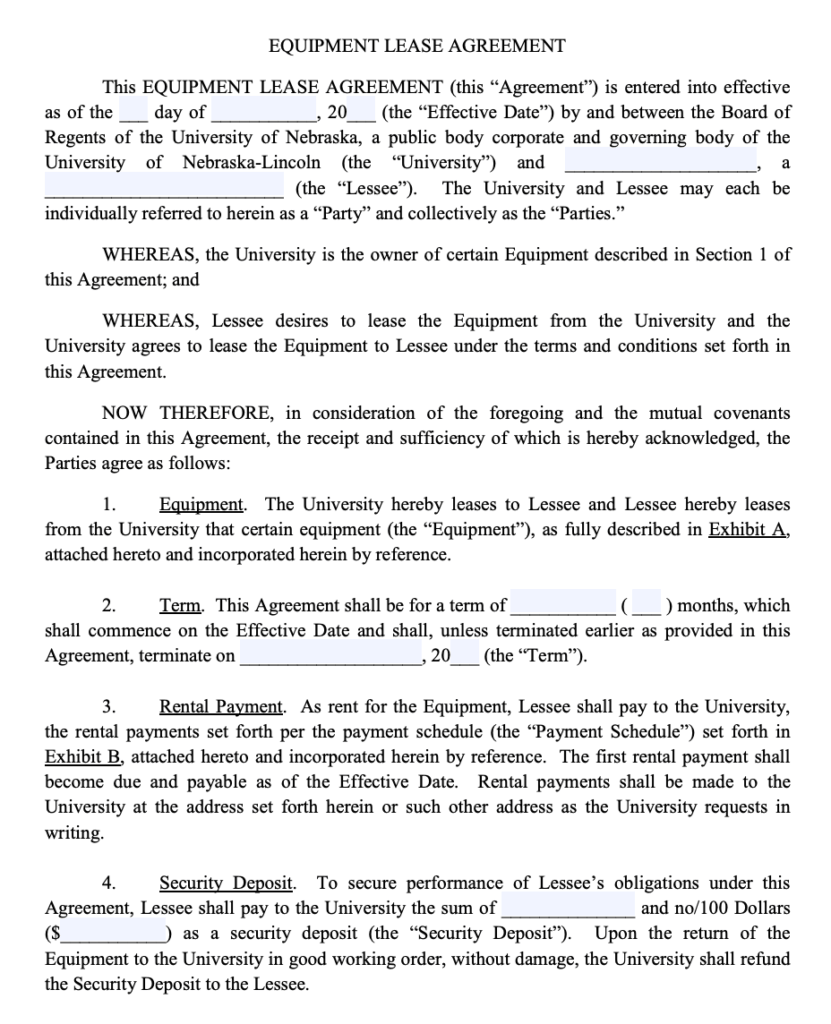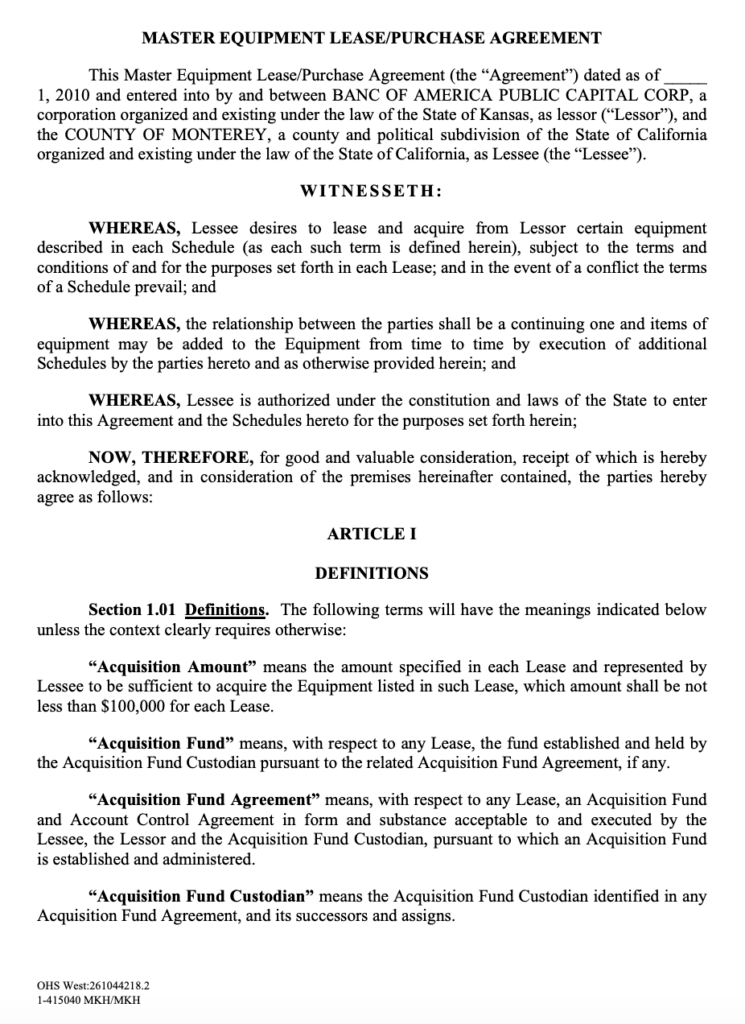
Equipment rental is a vital aspect of the construction industry. Contractors need specialized equipment to complete a project, but they don’t want to spend a ton of money to purchase it outright. They know they’re unlikely to use it often enough to justify the purchase. If you’re renting equipment to contractors, you’ll need an equipment rental agreement.
It’s a basic business mindset: Why buy the equipment and deal with the depreciation when you can rent it whenever you need it? Likewise, if you own a piece of equipment that you don’t use often, you wouldn’t let it sit there and rot when it could be producing income (or at least helping pay for itself).
Don’t worry, though — you don’t have to come up with the entire agreement yourself. You can reference our list of templates and samples below to help you square away your rental agreements.
Free Equipment Rental Agreement Template
This template is a general equipment rental agreement. It includes payment terms, equipment location, and logistics.

Download the template
Types of equipment rental agreements
In general, there are two different types of rental agreements, and they tailor toward different outcomes: In a standard lease agreement, the lessee returns the equipment at the end of the terms. In a lease-to-own agreement, the lessee potentially has the option to purchase the equipment at the end of the contract period.
Standard lease agreements
A standard lease agreement is just how it sounds. It’s fairly straightforward and the terms are clear. The lessee pays on a set basis for the right to keep the equipment and use it according to the terms. At the end of the agreement, the lessee returns the equipment to the lessor.
Lease-to-own agreements
A lease-to-own agreement can be an attractive option if the lessee is considering purchasing the equipment.
Under this agreement, the lessee pays the lessor for the right to keep and use the equipment but has the opportunity to purchase the equipment at any point during the lease. They also have the opportunity to return the equipment at any point during the lease, ending the agreement.
Examples of equipment rental agreements
Sample Lease Agreement from the University of Nebraska
This is more of an example than a template, but you can use it to draw up your own agreement. It’s nine pages long and includes items like required insurance, damages, maintenance, and taxes. The clauses are pretty extensive.

Download the sample
Monterey, CA Lease-to-Purchase Agreement
If you’re entering into a lease-to-own scenario, this template is definitely worth familiarizing yourself with. It includes all of the same basic information but with a predetermined purchase price.

Download the template
For another example of a lease-to-own agreement, you can also check out the Commercial Equipment Lease to Purchase Agreement from US Security and Exchange Commission.
Common clauses in equipment lease agreements
There are a few common clauses you might consider including in your lease agreements. Here are a few of the most common ones:
Restrictions
Detail if there any restrictions on how the lessee can use the equipment. Include things like whether they can modify it or use it outside of the manufacturer’s intended use.
Logistics
It’s worth including how the equipment will get to the job site. Is it an owner-delivery or will the leasing contractor pick it up? What about returning the equipment? How’s it getting back to your shop?
Maintenance
Is it the lessee’s responsibility to maintain the equipment? If so, it’s worth including in the equipment rental agreement.
Payment terms
The length of the lease, the amount of each payment, and the purchase price (in a lease-to-own scenario) are also important to include in the agreement.
You want to get as much in writing as possible so there are fewer questions. Other points to consider include are:
- Who is responsible for taxes and fees
- A security deposit
- Necessary insurances
- The grace period (if you choose to offer one)
Equipment rental disputes
Since we’re covering equipment rental agreements, it’s worth pointing out some common rental disagreements as well.
Some common disputes or challenges that can occur in a rental scenario include:
- Missed payments
- The lessee returns the equipment in poor condition
- The equipment fails due to poor maintenance, causing the project to fall behind
- The lessee modifies the equipment without the right to do so
- The lessor can’t find the lessee, or equipment to repossess it
There are many, many more potential arguments, but those are the most common. A detailed agreement and a background check can avoid most of these issues.
Payment rights for equipment rental companies
There are some risks involved in renting or leasing equipment: The contractor might not maintain the equipment, or they might not use it properly. In the scenario that you need to collect the equipment, you could be unable to physically find it. The good news, however, is that equipment rental companies generally have mechanics lien rights.
If you supply a piece of equipment to a job site, and the contractor uses that piece of equipment to permanently improve the property, most states allow you to file a mechanics lien for missed payments.
This is why it’s a good idea to send a preliminary notice on any project to which you supply a piece of equipment. A preliminary notice can help protect your payment, as the lessee will understand that you’re willing to file a mechanics lien in case of non-payment.
